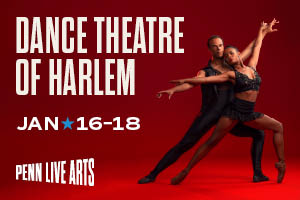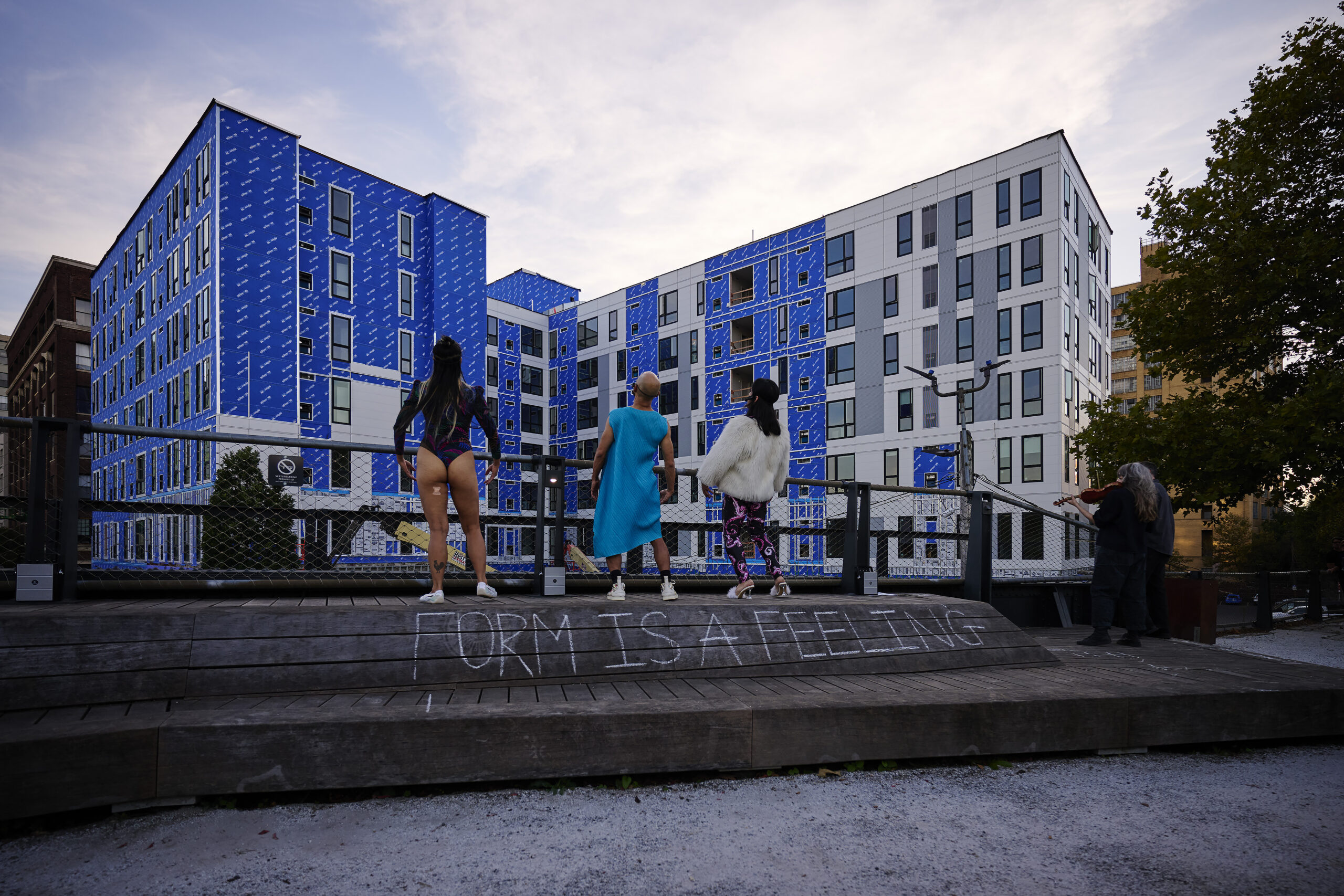After spending an engaging few weeks listening to their podcast, I jumped on a zoom call with Dancing Through The Lens hosts Clare Schweitzer and Chris Ouellette. We talked film festivals, collaboration, accessibility, and how screen dance has affected dance-making in recent years.
Emilee Lord: Can you give me a few sentences about who you are, what you do, and how you’re involved in the podcast?
Clare Schweitzer: My name is Clare Schweitzer. .jpeg) My pronouns are she/they, and I wear many different hats at the intersection of dance and film. I am a long-time staff member of the San Francisco Dance Film Festival. I’m a programmer, editor, podcaster, choreographer, videographer, and dancer. I recently presented at the Screen Dance State-of-the-Art Symposium and am also the co-host of FRAMEFORM podcast.
My pronouns are she/they, and I wear many different hats at the intersection of dance and film. I am a long-time staff member of the San Francisco Dance Film Festival. I’m a programmer, editor, podcaster, choreographer, videographer, and dancer. I recently presented at the Screen Dance State-of-the-Art Symposium and am also the co-host of FRAMEFORM podcast.
Chris Ouellette: And I’m Chris Ouellette. .jpg) You can use he/him. I was a professional ballet dancer. I trained at San Francisco Ballet School on a full scholarship starting at age eight. I went on to the Pittsburgh Ballet Theater for two seasons, was a dancer for Disney Cruise Line for two years, then Les Ballets Trockadero de Monte Carlo snatched me up. I traveled with them for five seasons as a drag ballerina. I am now the Company Manager for Axis Dance Company in San Francisco and the Art Director for Second Cast Productions, a Bay Area drag Production company. And now a podcast host!
You can use he/him. I was a professional ballet dancer. I trained at San Francisco Ballet School on a full scholarship starting at age eight. I went on to the Pittsburgh Ballet Theater for two seasons, was a dancer for Disney Cruise Line for two years, then Les Ballets Trockadero de Monte Carlo snatched me up. I traveled with them for five seasons as a drag ballerina. I am now the Company Manager for Axis Dance Company in San Francisco and the Art Director for Second Cast Productions, a Bay Area drag Production company. And now a podcast host!
EL: Dancing Through The Lens is associated with the San Francisco Dance Film Festival. How did this come about?
CS: During the pandemic, people were spending a lot of time at home, and we saw this kind of explosion of dance film content. Now, screen dance is not a new form at all, but it’s a form that’s not well documented and or consolidated. There isn’t one place to see the work and discuss it, and SFDFF wanted to put some archival material out there. We have a lot of panel discussions and artists’ Q and A’s that haven’t seen the light of day. This idea transitioned to conducting remote interviews with different artists who either we’ve screened or worked with at SFDFF or that have an association with dance and filmmaking communities. I started this initiative with [first season’s] co-host, Coral Martin. We didn’t just focus on speaking with people doing work for cinematic screens but also on various dance filmmaking roles and manifestations (i.e., internet content, use of archival material, etc.).
EL: You’re in the second season. When you look at your intentions for doing this and how it’s gone thus far, has it filled the need you saw?
CS: Looking at the trajectory from season one to season two, we have listening stats. But I’ve also received positive input from dancers in the community. I think [artists] only have space to talk process if they are working on grant applications. It’s usually on paper, and it’s usually a lonely process too. And so, having the opportunity to vocalize helps the person participating in the interview and might also help someone else reflect.
CO: Speaking for myself, being a dancer, and working behind the scenes artistically with AXIS and Second Cast, I enjoy hearing about what it takes to make a dance film. That’s what I love about podcasts—getting time with the creators.”
CS: And I want to add that one of our earliest episodes was an interview with the artistic directors of Ballet 22. They’re a company of men/mxn performing en pointe. We were among the first to interview them, as they started during the pandemic. We had the opportunity to spotlight them before they even took to the stage. They were later named Dance Magazine’s 25 to Watch. It’s huge for young companies and burgeoning artists to have that exposure, not just to reach audiences but also to have something that counts as press early on.
CO: Yeah. Their first performance was a film. So that was their entrance.
EL: thINKingDANCE has a lot of conversations about who gets press and whether we are reachable, so our platform can promote, highlight, make visible, et cetera.
CS: Along those lines, [we are] specifically highlighting artists connected to the San Francisco Bay Area. Because a lot of media related to US dance tends to center around New York, and a lot of the dance history that we know comes from New York because that’s where it’s most well documented. And in the Bay Area, it’s much more discrete. Especially with print press phasing out, many of these companies are getting covered less. We can record what’s happening and emphasize SF as a center for dance. That’s something I value.
CO: With dance on film, it’s making something usually reserved for a proscenium theater venue available to many people. So I think the accessibility of dance on film is a new territory that has come out of the pandemic.
EL: Yeah, one of the things I noticed in listening through the podcast is this discussion of how dance film allowed artists to continue to make. And the form continues to grow now that theaters are back in person. It’s shifting dance making in many ways, but also shifting dance viewing and accessibility in ways I think we’ve needed for a long time.
CO: You said the right word. It shifts. Dance on film—it’s a new eye, and you get a more intimate perspective.
EL: I loved the language used in the first episode where you interviewed Robin Dekkers in season one. “Film can amplify choreography’s intentions.”
CS: But screen dance is in no way new. It was movement that started film. Leland Stanford commissioned Eadweard Muybridge to take pictures of his horse. And that breaking down of movement catalyzed the creation of film and movement as a basis for film. It’s this sense of hybrid creation that has been a practice for well over 70 years. It’s a form that encompasses many things and needs to be looked at on its terms.
EL: Speaking of hybrid creation, many interviews discuss the collaborative process. What does each of you bring to your collaboration on this podcast?
CO: Well, Claire’s a seasoned pro at this. I was approached by Linda Schaller, who works with SFDFF, to host this season, and she’s very familiar with my dance origins. My introduction to dance on film was through the tv series Great Performances presented by KQED, a local television station where she used to work. At two, I was shown a performance by the San Francisco Ballet, which influenced my career. And I’ve been in two documentaries on Les Ballets Trockadero. One is “Rebels on Pointe,” shown at SFDFF in 2017
CS: Every podcast episode is almost a magic show because you create something from minimal resources. We meet quarterly to discuss potential guests and alternate taking the lead on interviews. If we have time, we’ll run questions with each other.
CO: And some questions, of course, are in real-time.
CS: We mostly record remotely on zoom. We’ll each record individually with external devices and edit together.
EL: Are you editing the audio?
CS: Yep. We’ve recorded most of our episodes at Berkeley Ballet Theater. But to go back, we throw away questions too. A great example is Chris’s episode with the I Just Wanna Dance team. Most of the interview was the team bouncing off each other and showing what the collaborative spirit was like in that film. You have all this preparation that you do, and still, you are conversing with someone, engaging with them and their work. You always want to be open to the magic that happens in the moment.
EL: I thought the interview with Tori Lawrence felt like that. She was very generous in the way she spoke. So, are there places of entry for someone who hasn’t listened yet, who maybe isn’t a “start at the beginning and catch-up” kind of person?
CS: Episode two, season two, Chris Ouellette. Chris is someone who shows that a dance career doesn’t follow a template. Like it can manifest in so many exciting ways. The episode with Evie Ladin is another. Her work focuses on the body and the sonic elements in dance films. She does a great job of providing a very accessible intro into Appalachian music and how that manifests in her practice. Also, she gives many practical tips for sound in screen dance, which, as someone who watches a lot of films for programming, sound tends to be the most neglected part of it.
CO: My first interview on the film, Steps Of Freedom. Maybe [some] people are more familiar with dance on TikTok and through that screen, which was a great way to segue that audience into something broader. It starts very small with a pop culture artist you may know like Megan Thee Stallion (which is a jumping-off point) to the history and culture of Irish step dance.
EL: So how can readers find this archival material you mentioned earlier, and how do they find you?
CS: On social media, I am @clschweitz. Chris is @couellette87. You can find the link to the podcast on the SFDFF social media page. You can also find us on Apple and Spotify. Make sure you like and subscribe – feed the algorithm! The festival also has a YouTube channel.
Dancing Through the Lens, bimonthly podcast, San Francisco Dance Film Festival





